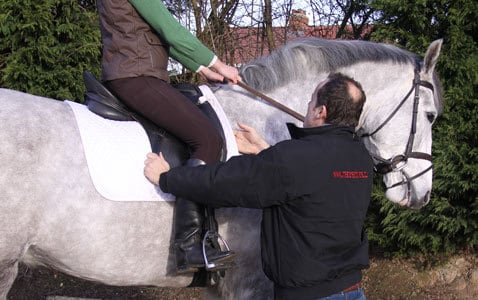Essential saddlery advice from the Society of Master Saddlers

Your horse’s saddle is the most important piece of kit you will buy him. We spoke to the Society of Master Saddlers to find out how you can make sure it lasts for many years to come.
1. Whether you buy a new or second-hand saddle, it should be fitted by a member of the Society of Master of Saddlers. Their first consideration will always be the horse. This may mean you need to adjust any preconceived ideas you have about your own preferences in relation to make and design.
2. If you MUST use a numnah or gel pad the saddle fitter must be informed before the saddle is fitted. Adding a numnah under a saddle that fits well is akin to putting thick insoles into shoes that fit perfectly without them.
3. Each horse should have his own saddle. Just as a pair of shoes adapts to the wearer’s foot, the saddle adapts to the contours of the horse.
4. A horse changes shape regularly, according to his age, training and management etc. Viewed on a daily basis, the changes may seem inconsequential, but over a period of just a week or so they can be surprisingly substantial. Try to develop an eye to recognise these changes and have your saddle checked regularly, so any necessary adjustments can be made.
5. ‘Feed’ your saddle carefully. Insufficiently treated the leather will dry out. Fed too much, the dressing will not be absorbed and the saddle will be unpleasantly sticky – possibly marking your clothes – or causing the saddle stitching to rot.
6. Weak or defective stitching on any part of the saddle should be repaired instantly. Saddles should be checked every time they are used and equal attention should be paid to girths and leathers.
7. Mounting from a mounting block should not be restricted to the less-than-athletic! It is infinitely better for the horse’s back and guards against the saddle tree becoming twisted. If you insist on mounting from the ground be aware that the stirrup leathers should be swapped over regularly to avoid the near-side leather becoming longer/stretched.
8. Great attention must always be paid to the condition of the saddle flocking. Irregular, uneven or lumpy flocking can cause pressure points that may seriously damage the horse’s back. Problems can also occur if the saddle is is over stuffed. Correct flocking provides a cushioning effect that helps to reduce trauma.
9. It is important to ask the saddler to check your saddle if your horse falls, as broken/cracked trees can be difficult to detect. Likewise, if the saddle falls from the saddle rack or is dropped it should be checked over by a qualified saddler.
10. The size of the stirrup irons should be checked when a different rider exercises the horse. Irons that are either too small or too large can be the cause of serious accidents.
You can find out about the incredible workmanship that goes into making your saddle in the latest episode of Rudall’s Round-Up, which see Jenny at the Society of Master Saddlers’ National Saddlery Competition.
Rudall’s Round-Up: Master Saddlers is available to watch online now via Horse & Country Catch Up and Amazon Video.






